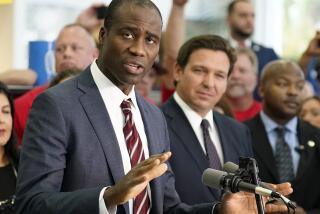Obama: Fighting for a better perception of healthcare law
The success or failure of the sweeping federal healthcare law will be measured over months and years by Americans whose lives are affected, for better or worse, by its impact.
But before that reality is felt, there is the public’s perception, which will go a long way toward shaping its future.
President Obama held a Rose Garden event Monday morning with two goals: to convey a sense of urgency about fixing the problems that have confounded those trying to sign up for insurance using the program’s online insurance site, and to split the divergent group of Americans who oppose Obamacare right now.
Two polls released Monday showed how, at this point, opponents of the healthcare law have benefited from opposites attracting.
PHOTOS: The battle over Obamacare
A CNN poll found that only 41% favored the healthcare law, with half of Americans opposed to it.
But only 38% opposed it because it was too liberal, the argument made by members of Congress and activist groups on Capitol Hill and across the country. An additional 12% opposed it because it didn’t go far enough. So, the pollsters noted, taken another way 38% of Americans oppose Obamacare and 53% either support it or want it to go further.
An ABC News/Washington Post poll showed roughly the same thing. Overall, 46% supported the healthcare program and 49% opposed it. But among the opponents, 36% said the measure goes too far, and 10% said that it didn’t go far enough. (The others had no opinion.)
That split explains both part of Obama’s approach Monday and the difficulty his opponents have had in coalescing public opinion against the healthcare law even with its early difficulties.
Given the virulence of some opponents — in the CNN poll, only 6% of tea party adherents backed the healthcare law — a natural target audience for Obama is the group of Americans frustrated that he didn’t favor a government-run, Medicare-style single payer program for all.
His argument to them: This beats what we had before.
After enumerating the benefits of the program so far — coverage for young adults on their parents’ policies, coverage for preexisting conditions, coverage for items such as mammograms and contraception, coverage for seniors’ prescriptions — Obama added:
“We waged this battle to make sure that millions of Americans in the wealthiest nation on Earth finally have the same chance to get the same security of affordable quality healthcare as anybody else. That’s what this is about. And the Affordable Care Act has done that.
“People can now get good insurance. People with preexisting conditions can now afford insurance. And if the launch of this website proves anything, it’s that people across the country don’t just need that security, they want that security.”
Obama said he was “willing to work with anyone on any idea to make this law perform even better.” But opponents have focused their attention only on killing the program, not replacing it. That has limited their ability to wholly unite its foes. Those who oppose Obamacare because it doesn’t go far enough are hardly entranced by an alternative of nothing.
To be sure, the program’s organizational stumbles are a threat to its supporters and a boon to its opponents. Obama took pains Monday to note that the website is not the entirety of the program, but the fact remains that the administration figured its website would be the road most Americans took to sign up for the plan.
Absent a workable website, as the president noted, those needing insurance can sign up by phone or in person, but a faulty website certainly sends a not-ready-for-prime-time signal that could turn wobblers against the program. Fixed quickly, the early difficulties will fade; technical issues that persist could convince some that it’s not worth the effort.
But even before the recent complications, those who have studied healthcare counseled that it would take time to divine whether the program was a success or a failure.
Drew Altman, president of the Kaiser Family Foundation that studies healthcare nationally, predicted some of the uncertainty in a column published just before the insurance exchanges opened Oct. 1.
Unknown for weeks or months will be the number of Americans who sign up for the program; after that it will take time for their perceptions to form about the affordability of the insurance and their access to medical care, he said. And later still will come their views on what they have to pay, which they will learn as they use the insurance they have purchased.
“All this will probably take at least a year to shake out, and maybe longer,” he said.
Twitter: @cathleendecker
More to Read
Sign up for Essential California
The most important California stories and recommendations in your inbox every morning.
You may occasionally receive promotional content from the Los Angeles Times.











